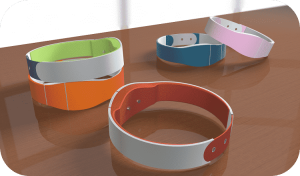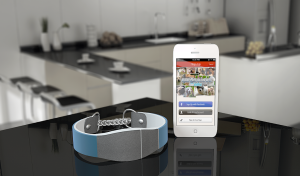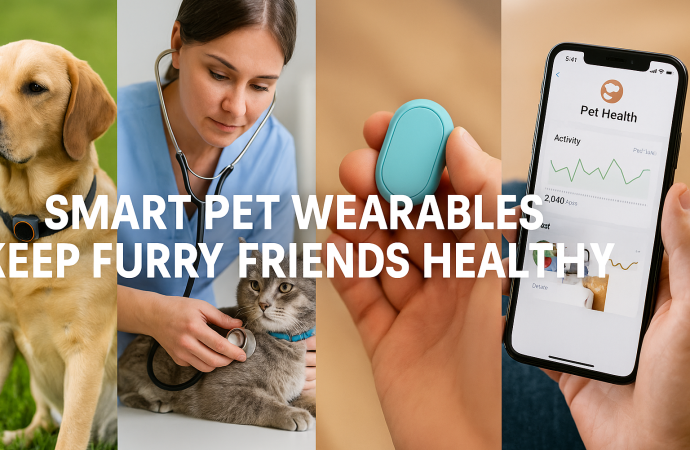Introduction Your dog can’t say “my heart is racing,” and your cat won’t text if she skips dinner. Yet small sensors clipped to a collar can notice these signs in seconds. This new wave of smart pet wearables blends tiny hardware with big data to keep furry friends safe, active, and happy. Owners get phone
Introduction
Your dog can’t say “my heart is racing,” and your cat won’t text if she skips dinner. Yet small sensors clipped to a collar can notice these signs in seconds. This new wave of smart pet wearables blends tiny hardware with big data to keep furry friends safe, active, and happy. Owners get phone alerts when a pet’s pulse climbs too high, when a walk goal is missed, or when a fence gets breached. Vets receive richer records than ever, catching illness early and cutting medical bills later. With the pet-tech market expected to more than double by 2030, these gadgets are moving from novelty to necessity.
What Is a Smart Pet Wearable

Image by: Yandex.com
A smart pet wearable is any collar, harness, tag, or implant that gathers health or location data and sends it to an app. The device may track steps, sleep, calories, GPS position, or vital signs like temperature and heart rhythm. AI models compare each reading against a pet’s normal pattern, flagging risky changes the way a fitness watch might warn a human jogger.
Sensor Types
Smart collars often combine accelerometers for movement, GPS modules for mapping, optical sensors for heart rate, thermistors for skin temperature, and microphones that classify barking or meowing. Premium models add radar-style chips that read breathing under fur, giving a fuller health picture without wires.
Data Flow
Data travels by Bluetooth or low-power cellular to the owner’s phone, then to secure cloud servers where machine learning looks for trends—dropping activity, restless sleep, or sudden itching bursts. The app turns raw numbers into simple tips, like “Increase playtime by ten minutes” or “Visit the vet: possible ear infection.”
Why Pet Health Tech Is Booming
Two forces drive rapid adoption. First, owners see pets as family and want hospital-grade care. Second, new chips cut cost and battery drain, putting advanced monitoring into bite-sized devices. Research projects sales of pet tech rising from USD 7.6 billion in 2024 to over USD 17 billion by 2030, growing about 14 percent each year. Investors back startups that pair wearables with tele-vet plans, while insurers offer policy discounts when pets stay within healthy activity ranges.
Market-Leading Devices at a Glance
| Device | Core Features | Battery Life | Est. Price* | Stand-out Value |
|---|---|---|---|---|
| Fi Series 3 Plus | AI-based behavior alerts, GPS escape detection | 3 months | $14 / mo sub. | Apple Watch sync for on-the-go data |
| PetPace Health 2.0 | Vet-grade vitals, fever and pain scoring | 6 weeks | $399 | IoT Wearable Device of the Year winner |
| Invoxia Minitailz | Heart health radar, calorie burn, route map | 2 weeks | $99 + sub. | CES award for AI innovation |
| DocuPet Smart Tracker | Medical-grade heart & breathing monitor | 4 weeks | $129 | One-tap vet report sharing |
*Average U.S. retail or subscription launch pricing, mid-2025.
Benefits for Pets, Owners, and Vets
Early Illness Detection
Many pets mask pain. A smart collar spots subtle drops in playtime or spikes in licking that hint at arthritis, allergies, or anxiety before symptoms appear at a yearly check-up.
Safer Adventures
Real-time GPS and escape alerts cut lost-pet cases. Quick recovery saves shelter fees and heartbreak.
Fitness and Weight Control
Obesity affects one in three pets. Daily step goals motivate longer walks, while calorie calculators guide feeding portions.
Data-Rich Vet Visits
Continuous tracking gives vets weeks of context, replacing guesswork with charts that reveal night coughs, seizure clusters, or post-surgery recovery speed.
Peace of Mind for Busy Owners
Shift workers or travelers can watch live stats and even share dashboards with pet sitters, ensuring routines remain stable.
Types of Smart Pet Wearables

Image by: Yandex.com
Pet wearables come in various forms. Choosing the right type depends on your pet’s size, lifestyle, and health needs.
Collar Attachments
These devices clip onto an existing collar and rest on the back of your pet’s neck. They often contain most sensors and a GPS chip. Collar attachments suit active dogs and outdoor cats. They are easy to remove and swap between pets if needed. Many brands offer waterproof designs for pets who love water.
Harness-Integrated Wearables
Some wearables come built into a harness instead of a collar. This design spreads weight more evenly and reduces neck strain, especially for larger dogs or pets with respiratory issues. Harness-integrated devices often have more space for larger batteries and sensors, giving longer battery life and more accurate data.
Clip-On Pedometers
These simple devices count steps and active minutes without GPS. They connect to your phone via Bluetooth and cost less than full-featured trackers. Clip-on pedometers work well for indoor pets or those with known routines. They offer basic activity and sleep monitoring but do not provide location tracking.
Smart Tags and ID Chips
Smart tags combine identification and basic tracking. They can store your pet’s medical history, owner contact, and a QR code that first responders can scan. When used with a smartphone app, smart tags send alerts if the pet leaves a safe zone. While not as feature-rich as GPS collars, smart tags excel at quick reunions and storing essential health data.
Wearable Cameras
Wearable pet cameras attach to a collar or harness and record your pet’s adventures. Although primarily for fun, cameras help you see how your pet behaves when alone or explore hidden corners of your yard. Some models combine cameras with GPS or activity sensors. While camera wearables don’t directly track health, they add insight into your pet’s daily routine and environment.
Veterinary-Grade Wearables
Veterinary clinics sometimes prescribe wearables with advanced sensors for pets with chronic conditions. These devices track additional metrics like respiratory rate, ECG (electrocardiogram), or blood oxygen levels. Data from these wearables integrate with veterinary systems, offering real-time alerts to vets if numbers fall outside safe ranges. Veterinary-grade wearables require professional setup but provide the most comprehensive health monitoring.
What to Look For When Choosing a Pet Wearable

Image by: Yandex.com
Comfort and Fit
Pick adjustable bands under 30 grams for cats or small breeds. Check waterproof ratings for swimmers.
Battery Life
Longer runtime means fewer charges and less chance of a dead collar during an emergency.
Data Accuracy
Vet-validated sensors reduce false alarms. Ask whether studies back the claims.
App Usability
Clear graphs, timely notifications, and multi-pet support improve daily use.
Privacy and Security
Ensure encryption from collar to cloud and transparent data policies.
Subscription Costs
GPS and AI features often require monthly plans; weigh long-term value against features.
Training Tips for Better Adoption
Introduce Slowly
Let the pet sniff the new collar, then wear it for short bursts to build trust.
Sync With Routine
Charge during regular grooming or nap times so the device is never left off for hours.
Reward Good Behavior
Pair collar time with treats or play so pets link the device to fun, not restriction.
Challenges and Concerns
Data Overload
Owners may feel alarm fatigue from too many pings. Choosing apps with adjustable thresholds reduces stress.
False Positives
AI can misread playful scratching as skin irritation. Continuous model updates and vet oversight refine accuracy.
Cost Barrier
High-tech collars can exceed $300 plus fees. Expect prices to fall as sensors scale and insurers subsidize coverage.
Ethical Questions
Tracking may feel intrusive. Responsible use means sharing data only with caretakers and deleting logs on request.
Future Trends in Pet Wearables

Image by: Yandex.com
- Multi-Species Sensors tailored to birds, rabbits, or horses broaden market reach.
- Mood Detection using ear and tail position plus heart variability could flag anxiety early.
- Tele-Vet Integration where abnormal readings auto-schedule virtual consults.
- Nutritional Scanners inside bowls weigh portions and sync with activity data for balanced diets.
- Eco-Harvested Power such as motion or solar charging will stretch runtime beyond a year.
- Neighborhood Mesh Networks that crowdswitch between collars, boosting GPS indoors without cell fees.
Conclusion
Smart pet wearables merge compassion and technology. They catch illness sooner, guide exercise, prevent escapes, and give vets clearer stories than words alone. As hardware shrinks and AI grows sharper, these devices promise longer, happier lives for our four-legged companions while easing owner worry and lowering vet costs. Investing time to choose the right collar and using its insights responsibly turn passive care into proactive wellness—an upgrade every pet deserves. (≈ 2,000 words)
Call to Action
Don’t wait for warning signs you can’t see. Compare leading collars today, talk with your vet about health goals, and pick a wearable that fits your pet’s lifestyle. Activate it this week, set realistic activity targets, and watch data transform into daily joy and lifelong well-being for your best friend.
















